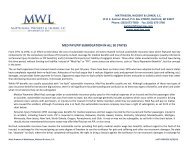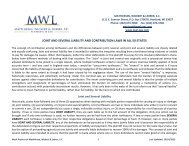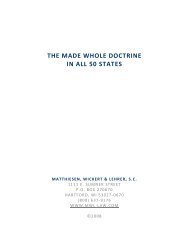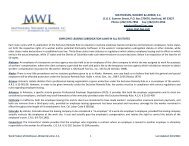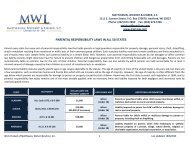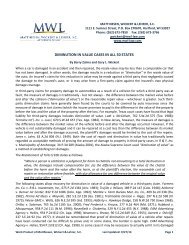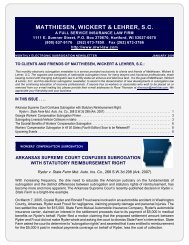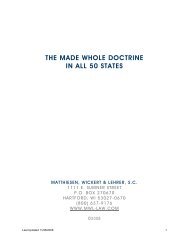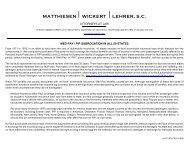spoliation of evidence in all 50 states - Matthiesen, Wickert & Lehrer
spoliation of evidence in all 50 states - Matthiesen, Wickert & Lehrer
spoliation of evidence in all 50 states - Matthiesen, Wickert & Lehrer
You also want an ePaper? Increase the reach of your titles
YUMPU automatically turns print PDFs into web optimized ePapers that Google loves.
destruction <strong>of</strong> evidential material is…admissible; <strong>in</strong> particular the destruction (<strong>spoliation</strong>) <strong>of</strong> documents as<strong>evidence</strong> <strong>of</strong> an admission that their contents are as <strong>all</strong>eged by the opponents.” 1 Greenleaf Ev. (16 Ed.), § 195, at325; Neece v. Neece, 104 Va. 343, 348, 51 S.E. 739, 740-41 (Va. 1905); Wolfe, supra.WASHINGTONADVERSE INFERENCE/REBUTTABLE PRESUMPTION: In Pier 67, Inc. v. K<strong>in</strong>g County, 89 Wash.2d 379, 573 P.2d 2(Wash. 1977), the Court held: “where relevant <strong>evidence</strong> which would properly be a part <strong>of</strong> a case is with<strong>in</strong> thecontrol <strong>of</strong> a party whose <strong>in</strong>terests it would natur<strong>all</strong>y be to produce it and he fails to do so, without satisfactoryexplanation, the only <strong>in</strong>ference which the f<strong>in</strong>der <strong>of</strong> fact may draw is that such <strong>evidence</strong> would be unfavorable tohim.” 89 Wash.2d at 385-86, 573 P.2d 2. To remedy <strong>spoliation</strong> the court may apply a rebuttable presumption,which shifts the burden <strong>of</strong> pro<strong>of</strong> to a party who destroys or alters important <strong>evidence</strong>. In decid<strong>in</strong>g whether toapply a rebuttable presumption <strong>in</strong> <strong>spoliation</strong> cases, two factors control: “(1) the potential importance orrelevance <strong>of</strong> the miss<strong>in</strong>g <strong>evidence</strong>; and (2) the culpability or fault <strong>of</strong> the adverse party.” Marsh<strong>all</strong> v. B<strong>all</strong>y’sPacwest, Inc., 94 Wash. App. 372, 381-383, 972 P.2d 475, 480 (Wash. App. Div. 2, 1999). In weigh<strong>in</strong>g theimportance <strong>of</strong> the <strong>evidence</strong>, the court considers whether the adverse party was afforded an adequateopportunity to exam<strong>in</strong>e it. Culpability turns on whether the party acted <strong>in</strong> bad faith or whether there is an<strong>in</strong>nocent explanation for the destruction. Id.WEST VIRGINIATORT OF SPOLIATION - INTENTIONAL SPOLIATION: West Virg<strong>in</strong>ia does recognize a tort <strong>of</strong> <strong>in</strong>tentional <strong>spoliation</strong><strong>of</strong> <strong>evidence</strong> as an <strong>in</strong>dependent tort when committed by either a party to an action or a third-party. Hannah v.Heeter, 584 S.E.2d 560, 563-64 (W. Va. 2003). The elements <strong>of</strong> the tort <strong>of</strong> <strong>in</strong>tentional <strong>spoliation</strong> consists <strong>of</strong>: (1) apend<strong>in</strong>g or potential civil action; (2) knowledge <strong>of</strong> the spoliator <strong>of</strong> the pend<strong>in</strong>g or potential civil action; (3) willfuldestruction <strong>of</strong> the <strong>evidence</strong> (4) the spoliated <strong>evidence</strong> was vital to a party’s ability to prevail <strong>in</strong> the pend<strong>in</strong>g orpotential civil action; (5) the <strong>in</strong>tent <strong>of</strong> the spoliator to defeat a party’s ability to prevail <strong>in</strong> the pend<strong>in</strong>g orpotential civil action; (6) the party’s <strong>in</strong>ability to prevail <strong>in</strong> the civil action; and (7) damages. Once the first sixelements are established, there arises a rebuttable presumption that but for the fact <strong>of</strong> the <strong>spoliation</strong> the party<strong>in</strong>jured by the <strong>spoliation</strong> would have prevailed <strong>in</strong> the pend<strong>in</strong>g or potential litigation. Id.NEGLIGENT SPOLIATION: West Virg<strong>in</strong>ia does not recognize <strong>spoliation</strong> <strong>of</strong> <strong>evidence</strong> as an <strong>in</strong>dependent tort whenthe <strong>spoliation</strong> is the caused by the negligence <strong>of</strong> a party to a civil action. Id.NEGLIGENT THIRD-PARTY SPOLIATION: West Virg<strong>in</strong>ia does recognize <strong>spoliation</strong> <strong>of</strong> <strong>evidence</strong> as an <strong>in</strong>dependenttort when the <strong>spoliation</strong> is the result <strong>of</strong> negligence <strong>of</strong> a third-party and that third-party had a special duty topreserve the <strong>evidence</strong>. Id. The element <strong>of</strong> the tort <strong>of</strong> negligent <strong>spoliation</strong> <strong>of</strong> <strong>evidence</strong> by a third-party consists <strong>of</strong>:(1) the existence <strong>of</strong> a pend<strong>in</strong>g or potential civil action; (2) the <strong>all</strong>eged spoliator had actual knowledge <strong>of</strong> thepend<strong>in</strong>g or potential civil action; (3) a duty to preserve <strong>evidence</strong> aris<strong>in</strong>g from a contract, agreement, statute,adm<strong>in</strong>istrative rule, voluntary assumption, or special circumstances; (4) <strong>spoliation</strong> <strong>of</strong> the <strong>evidence</strong>; (5) thespoliated <strong>evidence</strong> was vital to a party’s ability to prevail <strong>in</strong> the pend<strong>in</strong>g or potential civil action; and (6)damages. (There arises a rebuttable presumption that but for the fact <strong>of</strong> the <strong>spoliation</strong> <strong>of</strong> <strong>evidence</strong> the party<strong>in</strong>jured by the <strong>spoliation</strong> would have prevailed <strong>in</strong> the pend<strong>in</strong>g or potential civil litigation if the first five elementare met). Id.PUNITIVE DAMAGES: In actions <strong>of</strong> tort where willful conduct affect<strong>in</strong>g the rights <strong>of</strong> others appears a jury mayassess exemplary, punitive, or v<strong>in</strong>dictive damages. Id.ADVERSE INFERENCE: A trial court may give an adverse <strong>in</strong>ference jury <strong>in</strong>struction or impose other sanctionsaga<strong>in</strong>st a party for <strong>spoliation</strong> <strong>of</strong> <strong>evidence</strong> after consider<strong>in</strong>g: (1) the party’s degree <strong>of</strong> control, ownership,possession or authority over the destroyed <strong>evidence</strong>; (2) the amount <strong>of</strong> prejudice suffered by the oppos<strong>in</strong>g partyas a result <strong>of</strong> the miss<strong>in</strong>g or destroyed <strong>evidence</strong> and whether such prejudice was substantial; (3) thereasonableness <strong>of</strong> anticipat<strong>in</strong>g that the <strong>evidence</strong> would be needed for litigation; and (4) if the party controlled,17Work Product <strong>of</strong> <strong>Matthiesen</strong>, <strong>Wickert</strong> & <strong>Lehrer</strong>, S.C. LAST UPDATED 4/22/2013



